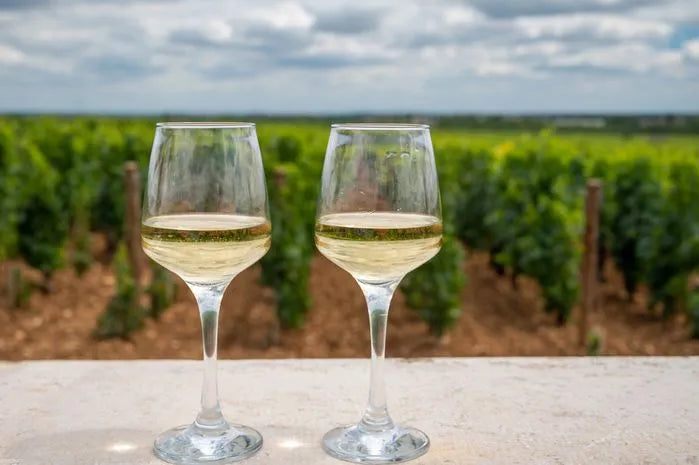What Is Chardonnay de Bourgogne? Explore Its Color, Taste Profile, and Characteristics Through Iconic Houses Like Louis Latour and Jadot
Why does it captivate both seasoned sommeliers and curious newcomers? At Casa Loce, we’ve tasted and studied countless vintages of white Burgundy over the years, and this guide brings you behind the label with insights drawn directly from our hands-on experience. From the subtle gold hues to the layered palate that shifts with every vintage and vineyard, we’ll walk you through what makes Chardonnay de Bourgogne so distinct.
Top 5 Takeaways
1. Terroir is Everything
- Grown in limestone-rich soils.
- A cool climate adds fresh acidity.
- Result: Balanced, mineral-rich wines.
2. Color Reflects Depth
- Young wines = pale straw.
- Aged wines = golden yellow.
- Darker color = richer flavor.
3. Flavor That Evolves
- Tasting notes: apple, citrus, tropical fruit, minerality.
- Oak aging adds vanilla or toast.
- Drinks well young or aged, depending on style.
4. Producers Define Style
- Louis Latour: Mineral, oak-aged, elegant.
- Louis Jadot: Wide range—from crisp to creamy.
- Both show how terroir and technique shape the wine.
5. Our Take
- We've tasted and cellared it all.
- Every bottle tells a new story.
- It’s not just wine—it’s Burgundian craftsmanship in a glass.
Understanding The Wine
This French classic, celebrated for its unmatched elegance and complexity, carries a deep-rooted history in the unique terroir of Burgundy.
Its grapes first took root in this region, thriving for centuries due to optimal weather and soil conditions. Limestone-rich earth and moderate weather combine to form an ideal environment for vine growth, producing wine reflective of its birthplace.
Terroir's influence shapes its complex taste. Minerality, a result of limestone and clay soils, blends with the natural acidity of Burgundy's cool climate, yielding a balanced, full-bodied wine with a lingering finish.
The Unique Color Profile
Factors such as the wine's age, fermentation oak type, and the exact vineyard location within Bourgogne heavily influence this wine's color intensity.
In its youth, it exhibits a straw-yellow shade, deepening to golden yellow as maturity sets in. Despite this, hue variations are widespread, owing to the diversity of Bourgogne's terroir plus the winemaking techniques employed.
Tasting Notes
Esteemed for its balance between acidity and creaminess, this wine delivers a rich, full-bodied palate. Taste buds detect primary flavors of fresh green apple, citrus, and tropical fruits, with a slight minerality. The winemaking process lends a whisper of vanilla or toasted oak undertones.
Its complexity opens up a wide range of food pairings. Creamy sauces, rich seafood dishes, and poultry find an excellent partner in its high acidity. Fruit and oak flavors also pair well with diverse cheeses and roasted vegetables.
Regarding aging potential, Chardonnay De Bourgogne presents a versatile option. Versions leaning towards freshness and fruitiness are enjoyable when young. In contrast, wines with more oak influence can mature beautifully over several years in the cellar.
Characteristics of Iconic Chardonnay Houses
Each embodies the essence of its vineyard location and employs distinct production techniques, crafting a captivating array of expressions.
- Traditional winemaking techniques are a hallmark of Maison Louis Latour, with vineyards nestled in the prestigious Côte de Beaune region.
- Embracing biodynamic farming, Domaine Leflaive owns prime Puligny-Montrachet region vineyards.
- Maison Joseph Drouhin blends modern with traditional techniques, boasting vineyards throughout Burgundy.
- A diverse range and high-quality offerings define Maison Louis Jadot, whose vineyards span from Côte d'Or to Mâconnais.
Louis Latour and Jadot: A Comparison
When examining Maison Louis Latour alongside Maison Louis Jadot, one gains unique insights into Chardonnay de Bourgogne's varied expressions. Both wineries boast rich histories, yet their vintages convey distinct stylistic differences.
In assessing Latour versus Jadot, the impact of terroir shines through. With its main base in Côte de Beaune, Latour embodies a mineral-centric style attributed to limestone-rich soil that imparts elegance with a fresh undertone. In contrast, Jadot's vineyards span multiple sub-regions, revealing a wide range of flavors and textures - from citrusy crispness to creamy richness.
The techniques used in vinification significantly influence the resulting wine. Latour adheres to classic methods, maturing wines in French oak barrels. Conversely, Jadot frequently dabbles in alternative methods, like stainless steel fermentation, to heighten the fruit essence.
"At Casa Loce, we’ve spent years tasting and comparing white Burgundies—from the sharp lift of young Mâconnais to the layered complexity of aged Puligny-Montrachets. Chardonnay from Bourgogne stands apart not only because of the soil but because each producer—Latour, Jadot, and others—expresses that soil in a unique way. We’ve pulled corks on vintages that hum with mineral tension and others that glide with creamy richness. This guide goes beyond tasting notes. It offers a firsthand perspective on the skill and intention behind every bottle."

Supporting Facts and Statistics
We’ve tasted, cellared, and studied Burgundy’s finest. Here’s what the science says—confirmed by years in the glass.
1. Terroir Is the Foundation
-
Limestone soils = structure + minerality.
-
A study by AJEV shows that soil directly affects grape aroma and balance.
- In our experience, stony vineyard slopes produce wines with sharper, cleaner profiles.
2. Climats Create Character
-
Burgundy has 1,247 climates, each with unique soil and sun exposure.
-
UNESCO recognizes them for shaping wine identity.
- We’ve walked many ourselves—each plot delivers distinct textures and flavor.
3. Aging = Evolution
-
Oak-aged white Burgundy improves with time—8–12 years for top-tier bottles.
-
Ideal storage: 55°F, 70% humidity, dark, vibration-free space.
- We’ve tracked the shift from citrusy youth to hazelnut and brioche richness.
Takeaway:
These stats back up what our palate knows—Burgundy Chardonnay is shaped by soil, place, and time. Every number tells a story we’ve lived and tasted.
Final Thoughts & Opinion
At Casa Loce, we’ve spent years tasting, cellaring, and sourcing Chardonnay de Bourgogne from Burgundy’s most iconic producers. Here's what we've learned—and why this wine continues to captivate us.
Why It Stands Out
- Chardonnay de Bourgogne is more than a wine—it’s a reflection of terroir, tradition, and winemaker intention.
- Each bottle tells a different story, shaped by region, technique, and philosophy.
- The best expressions are both honest and evolving—true to their roots, yet dynamic in the glass.
What We’ve Noticed from First-Hand Tasting
1. Louis Latour
- Mineral-driven and elegant
- Classic Côte de Beaune profile
- French oak aging brings subtle structure and depth
2. Louis Jadot
- Broad range of styles from multiple sub-regions
- From crisp, stainless-steel-aged freshness to rich, creamy textures
- A showcase of regional diversity in one portfolio
Our Opinion
- No two bottles are alike—and that’s the point.
- Chardonnay de Bourgogne rewards curiosity, patience, and exploration.
- Whether you’re new or experienced, there’s always something new to discover.
Our Suggested Journey
- Start with a village-level Chardonnay to build your palate.
- Explore both oak-aged and stainless-steel-aged styles to understand the range.
- Revisit past vintages—you may be surprised how beautifully they evolve.
Frequently Asked Questions
Is Bourgogne the same as Pinot Noir?
No, Bourgogne is not the same as Pinot Noir. Bourgogne is a wine region in France known for producing both red and white wines, and Pinot Noir is a grape variety. However, Pinot Noir is indeed one of the key grape varieties grown in the Bourgogne region.
Is Chardonnay Pinot Noir sweet or dry?
Chardonnay Pinot Noir is typically dry, not sweet. This blend of wine uses the Chardonnay and Pinot Noir grape varieties. The flavor profile and sweetness can vary, but generally, it leans more toward the dry side.
Is Burgundy the same as Chardonnay?
No, Burgundy is not the same as Chardonnay. Burgundy is a wine region in France, while Chardonnay is a type of grape. Chardonnay grapes are used to produce white wines in the Burgundy region.
What kind of wine is Bourgogne?
Bourgogne is a type of wine named after the wine region in France where it is produced. The Bourgogne region produces both red and white wines, and the primary grapes used are Pinot Noir for red wine and Chardonnay for white wine.
What is the difference between Chardonnay and Pinot Noir?
The difference between Chardonnay and Pinot Noir lies in the type of grapes used and the resulting wine. Chardonnay is a green-skinned grape variety used to make white wine, while Pinot Noir is a red-skinned grape variety used to make red wine. Their taste profiles are also different; Chardonnay is often described as having flavors of apple and pear with hints of citrus, while Pinot Noir typically has flavors of cherry, strawberry, and raspberry.
How do you pronounce Bourgogne Chardonnay?
You pronounce Bourgogne Chardonnay as boor-gawn-yuh shar-doh-nay. Bourgogne is the French name for the Burgundy wine region.
Why is Burgundy wine so special?
Burgundy wine is special due to its unique terroir, which is a combination of the region's climate, soil, and topography. This terroir results in high-quality grapes, which in turn produce distinctive and highly sought-after wines. The region is particularly known for its Pinot Noir and Chardonnay wines.
What is the difference between Bordeaux and Bourgogne wine?
The difference between Bordeaux and Bourgogne wine lies in the regions they come from and the grape varieties used. Bordeaux wines typically use Cabernet Sauvignon and Merlot grapes, while Bourgogne wines primarily use Pinot Noir and Chardonnay grapes. The resulting wines have different flavor profiles, with Bordeaux wines often being more full-bodied compared to the more delicate and complex Bourgogne wines.
Why is Bourgogne called Burgundy?
Bourgogne is called Burgundy in English because Burgundy is the English translation of the French word Bourgogne. Both refer to the same wine-producing region in France.
What is the French version of Pinot Noir?
The French version of Pinot Noir is simply Pinot Noir. This grape variety originated in France and is widely grown in the Bourgogne region.
What wine is equivalent to Pinot Noir?
In terms of flavor profile, the Italian wine Nebbiolo can be considered equivalent to Pinot Noir. Nebbiolo, like Pinot Noir, often features high acidity and complex flavors, although Nebbiolo can be more tannic.
What red wine is most similar to Burgundy?
The red wine most similar to Burgundy, which is made primarily from Pinot Noir grapes, would be wines made from the same grape variety. This could include wines from regions like Oregon in the United States or the Central Otago region in New Zealand, where Pinot Noir grapes also thrive.
Join us for a look into our elegant approach to winemaking and gracious hospitality. We welcome our members and their guests by appointment only. Become a member or book an event by visiting CasaLoce.com
Casa Locé
Upper Ojai California
10065 N Ojai Rd, Ojai, CA 93023
https://maps.app.goo.gl/E7YQCnXAFHq1bKz46




